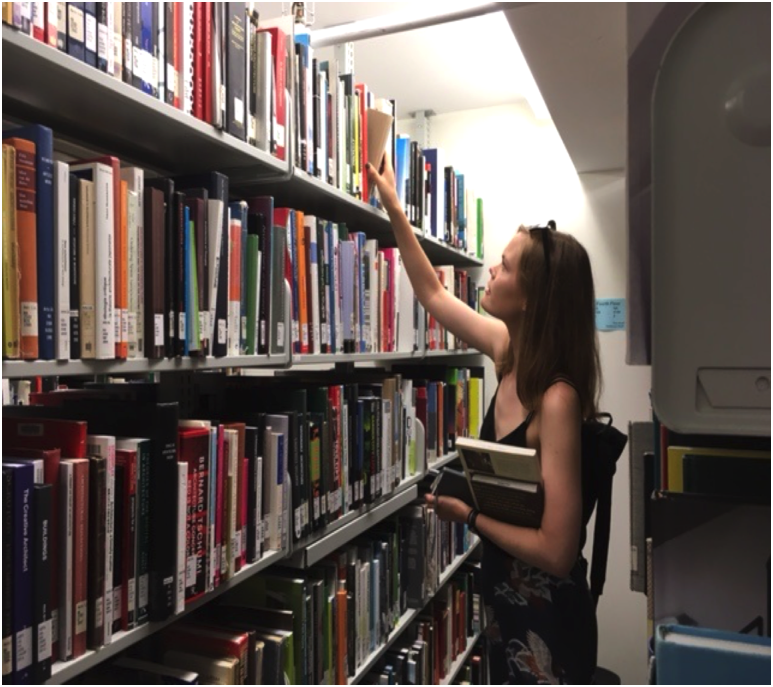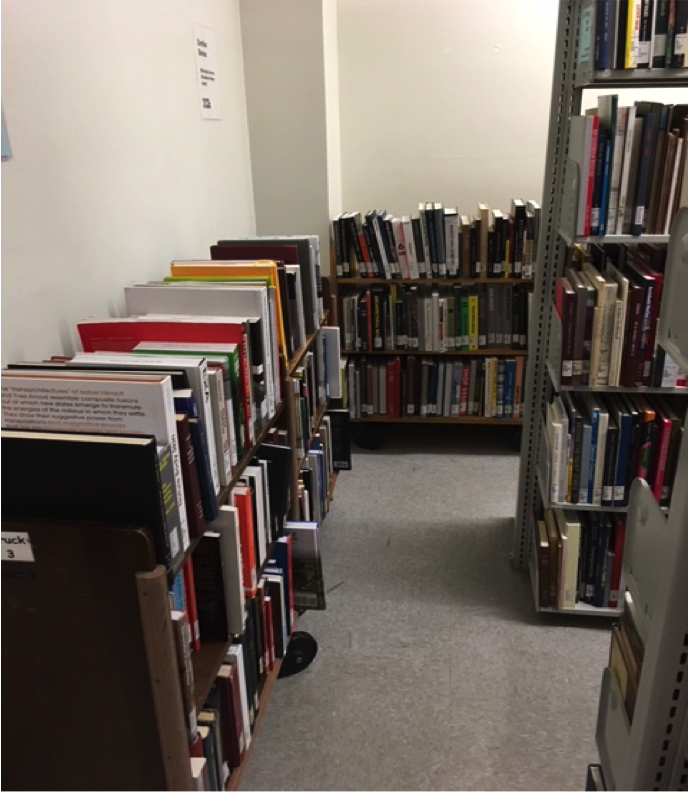Lucy Campbell and Barbara Opar, column editors
Column by Janine J. Henri , Architecture, Design, and Digital Services Librarian, UCLA Arts Library (jhenri@library.ucla.edu)
Many architectural publications are still only published in print. Not everything researchers need is available from architect or firm websites or blogs, and many older architecture titles have lasting research value. Faced with a broad collecting mandate in support of professional and academic degrees, and a library facility that reached capacity many years ago, selecting materials for remote storage has become a part of my weekly routine. Recurring queries on librarian discussion lists regarding selection of materials for storage is evidence that UCLA is not facing this issue alone.
Overflow books that cannot be shelved due to lack of stack space. The library has book trucks in aisles and every nook and cranny.
Many collection managers select material for remote storage or withdrawal based on circulation activity. However architecture collections are frequently browsed and used on site. Some books may be too heavy to carry to studios, workspaces may be unsecured, and when the library provides free scanning, scans may be all that are desired. Some libraries track in-house use, but this can miss researchers who sit in the stacks, perusing each book on a topic. Besides circulation statistics, how can we select materials for remote storage? My approach has been to consider the relationship between intellectual access, browsing, and expected use.

A student browses a section of stacks looking for suitable content.
For back issues of journals the decision is easier. The Avery Index to Architectural Periodicals does such a great job of indexing articles down to the project level, with descriptions of specific types of illustrations (plans, site plans, elevations, sections, models, axonometric views, etc.). Volumes can be retrieved from storage the same day or next weekday, depending on when a request is submitted. However book descriptions are less detailed. When a book concerns a single building (or project), we can expect that it is described in our library catalog with the name of the building (or project) as a subject. This subject access, plus the mention of illustrations and plans, is enough for a user to know whether the book is on topic. Users can determine (sight unseen) that these books are worth requesting, and I often select these types of books for remote storage. When a book features several buildings (as in discussions of typologies, materials, fabrication technologies, design methods, etc.), the book’s subject(s) will not necessarily include building names. Our users will be unable to determine which building might be illustrated from the description in the catalog. I am more likely to keep these types of books on site so researchers can browse them to quickly determine relevance. I also tend to keep books with plans that include a scale on site, since researchers frequently seek this information. I also use my knowledge of the curriculum, local research needs, and the ways different books are consulted, in order to decide what to store. For example, books used primarily by historians and theorists who tend to plan out their research and are able to wait a day for a book’s retrieval are better candidates for remote storage than books primarily used by designers who tend to have unanticipated research needs during the design process. At UCLA, which is on the quarter system, a single day delay can derail a project.
A section of stacks with books about tall buildings. Many patrons search for materials on a specific subject by browsing.
Several years ago when I discussed my storage selection process with a faculty member, he responded by stating he believed that we must keep as many highly illustrated books on campus as possible. One of his important considerations when browsing illustrated materials, is that he is looking for specific views or details. No bibliographic description will help him identify which title includes the one photograph that shows a building from the specific angle he seeks. Over time, through browsing, he has developed his own knowledge of which books have the specific views he needs to make his point (or that one view no one else has published), and he wants to make sure his students are also able to develop that kind of familiarity. I acknowledge that this way of browsing physical books is lessened somewhat by the growing availability of titles in Google Books, but since Google’s ‘snippet views’ do not necessarily show the needed illustrations, for now, browsing physical books in the stacks is still a core architecture research method.

 Study Architecture
Study Architecture  ProPEL
ProPEL 
